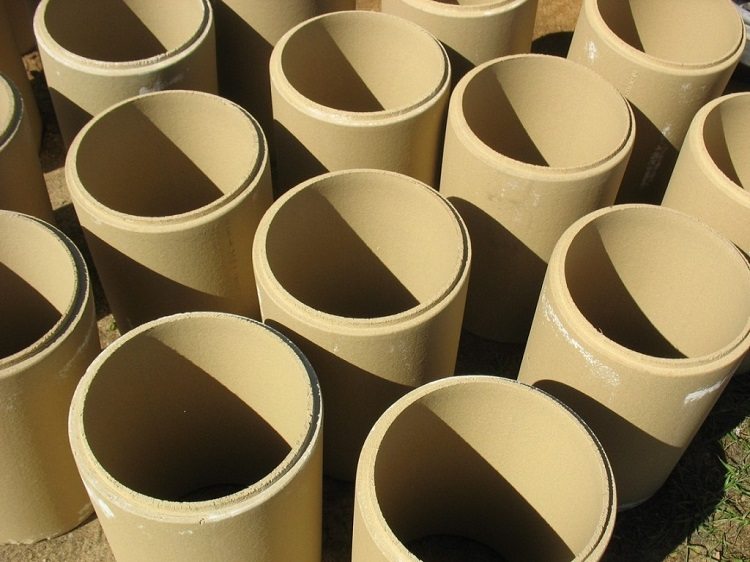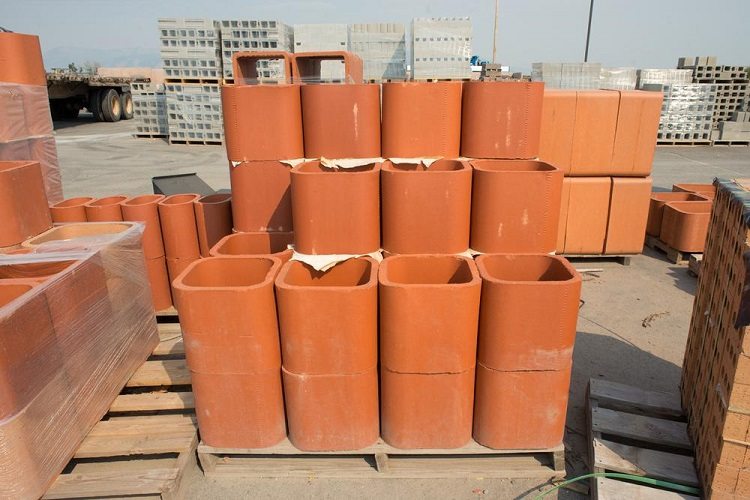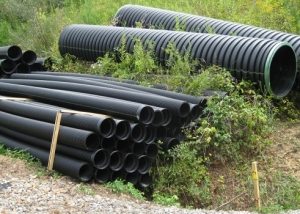A feature of such a chimney is that the blocks in the stone shell are made of ceramic material, and not of iron or brick. Such designs have begun to be used relatively recently and on an industrial scale they have so far been used little. However, in the construction of private cottages, ceramic pipes are increasingly used for chimneys.

From ceramic pipes create flue systems that are not inferior in reliability and durability to metal and brick structures
Content
Properties and features of ceramic pipes
Ceramic products have properties that distinguish them from all pipes that are used in chimney systems:
- simplicity in operation. Thanks to the smooth walls of the pipe, no burning and soot layers are collected inside it, which eliminates unnecessary care;
- durability. Such a pipe can last more than 30 years, as it is resistant to corrosion and sudden changes in temperature. This effect is achieved by treating the product with expanded clay mixture or with a special composition of mirror steel;
- resistance to mechanical damage;
- ease of processing. The ceramic pipe is easy to cut, drill and the quality of the product does not suffer;
- absolute water tightness;
- immunity to chemicals. This product is not afraid of fluorine compounds, solvents, chlorine and other chemicals;
- safety. Another advantage of ceramic chimneys is fire resistance, therefore, in case of soot ignition, the flame will not spread;
- accumulate heat well;
- ease of installation work, which reduces the likelihood of flaws and errors;
- good traction due to smooth surface. You will not have such problems as smoke in the room;
- nice value. Ceramics are not too expensive material; buying such a chimney, you get a perfect match price-quality.
Classification and advantages over metal pipes
Ceramic pipes are clearly superior in quality and durability to brick and metal. Although the use of brick and metal chimneys was always popular, they have a number of significant drawbacks. For example, the rough surface of brick blocks contributes to the accumulation of soot, which is unsafe. Brick is inferior to ceramics in moisture resistance, and therefore the service life of such a system is less. The metal is more susceptible to temperature changes, and also susceptible to corrosion. In addition, its service life may be reduced and when exposed to certain chemical compounds that emit certain types of fuel. The ceramic pipe is not afraid of this.
Ceramic pipes for chimneys are classified according to their shapes and functions. Products are:
- cylindrical;
- cylindrical with a supporting plane;
- perforated;
- faceted;
- corrugated (with a high degree of resistance to loads);
- with chamfers (this type is more often used for sewer communications);
- with curly ends.
In addition, systems are distinguished by the type of fuel for which they are designed.
Helpful advice! Some models are suitable for use by almost any furnace and boiler, both with liquid and solid fuels, but there are also non-universal designs. Pay attention to this when choosing.
Ceramic chimney construction
The complete set of chimneys made of ceramics is extremely simple and convenient for installation, repair, inspection and maintenance of the system. A ceramic chimney is a modular sandwich system consisting of several elements:
- The supporting structure (of stone, brick or concrete), inside which holes are made for further reinforcement. This will provide extra strength and stability.
- Ceramic blocks coated with special glaze.
- Thermal insulation in the form of plates that wrap the pipe. They prevent the formation of condensate, the sedimentation of soot and flue acids, harmful to health. In addition, they ensure the correct temperature from the outside of the chimney, and this is important if it passes through the living quarters.
The chimney is also equipped with additional elements. They are needed to prevent garbage, branches, precipitation from getting there; remove moisture from the pipe, simplify the process of inspection and cleaning, as well as connecting to furnaces, boilers and other thermal equipment.
Helpful advice! Make sure that the condensate siphon is at least 15 cm high and the total length of the chimney is at least 5 meters. The higher the chimney, the greater the draft.
If you install a ceramic pipe for heating a private house, remember that it should be at least 50 cm above the level of the flat roof, and at least 50 cm above the ridge and parapet. The diameter of the chimney should not be less than the chimney of the furnace or boiler. Dimension standards are specified in GOSTs, their observance will ensure safety during operation of the chimney.

The design of the chimney with a ceramic sleeve at the base necessarily includes heat-insulating blocks made of expanded clay concrete
Important points to install
Installation work is quite simple and does not require too much knowledge and many years of experience. Therefore, often the owners of cottages prefer to cope with this task on their own. However, there are some features, without which the installation will be of poor quality and, possibly, even dangerous. Therefore, certain rules and precautions should be studied and observed.
To make the installation process more comfortable and cheaper, it is better to complete it before installing roofing and rafter structures. Otherwise, in order to isolate the chimney, you have to disassemble the roof. If the building is wooden, then there may be problems due to the shrinkage of the house. It is better to consult a specialist who will give recommendations and calculate the terms of shrinkage. When installing a ceramic pipe for the chimney, observe the fire safety rules of SNiP.
As for reinforcement, there are three methods for its application:
- using corners and steel tapes;
- using steel rods with a cross section of 10 mm;
- concreting using metal rods.
Which method to choose depends on external factors, as well as on the type and chimney heights, features of its design and installation.
Note! Reinforcement is used only if the height of the chimney above the roof level is more than one and a half meters.
Materials and equipment
Before you begin installing the chimney, take care of the availability of everything you need.
In addition to conventional construction fixtures like a level, you will need special mortars. The first is cement. This is a standard mortar that is quick and easy to prepare. The second - acid-proof - you will need to process the seams at the joints of the modules.It consists of a special powder and water. They need to be mixed in a ratio of 7: 1, respectively. The temperature in the room where the work is carried out should be at least 20 degrees heat. You can use the solution only within a half hour of the mixing field, so prepare it just before you install the structure.
If a ceramic pipe passes through unheated rooms (for example, an attic), take care of the availability of materials for additional insulation.
As for the casing, often use GVL or fire-resistant drywall. However, if the pipe is installed in a bathhouse, a much better option would be a DSP - cement bonded particleboard. Sometimes they use LSU (glass magnesite), but this is a material unhealthy. Due to the content of magnesium chloride, which is susceptible to hydrolysis under the influence of high temperatures, hydrogen chloride is released. Inhalation of such harmful fumes leads to irritation of the respiratory system, tooth decay and other unpleasant consequences.
Installation of construction
The installation of ceramic chimneys begins with the specification of the connection point of the furnace and the construction of the foundation. It should be separate from the main foundation of the building. An exceptional case - if the foundation of the house is made of a monolithic slab, which provides reliable support. It is important that the base under the chimney is as flat as possible. A layer of cement mortar and a special module for connecting a boiler or furnace are applied to it.
Then, insulating plates are installed, after which the external blocks for the pipe are mounted. They should be located vertically. Make sure they are installed evenly. To do this, use the building level.
A special sealant groove runs along the upper edge of the ceramic pipe. Pour it on both sides on a cleaned sleeve. Try to work carefully, carefully remove excess solution. After that, you can install a siphon to drain condensate from the pipe.
Helpful advice! Particular attention is paid to the joints of the chimney modules. All should be available for regular maintenance and inspection. In addition, it is better not to place them in places where floor slabs pass. If this arrangement cannot be avoided, then additional insulation with non-combustible materials will be required.
If all the steps were performed correctly, then you will get a reliable and durable chimney system that does not require special maintenance or repair for many years.









